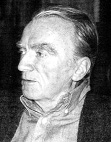
Jay Gluck
Jay Gluck was born in Detroit, Michigan, the son of Lillian Mary Veronica Friar (Campbell-Phillips) and Harry Fitzer Gluck, a musician.[1] He spent his childhood in New York's East Side and also lived in his mother's hometown of Newcastle, England for a short while. At 17, he joined the US Navy Air Arm. After the war, he attended different universities before graduating in Archaeology and Middle East Studies from UC Berkeley in 1949. He attended the Asia Institute School for Asian Studies, where he completed a two-year MA degree
Gluck was responsible for the republishing of the 19 volumes of The Survey of Persian Art after the original printing plates were destroyed in London in the Second World War.
Invited to Iran in 1966 by his former professor and mentor Arthur Upham Pope, Jay moved his family to Shiraz from Japan to take up the post of Acting Director of the Asia Institute of the Pahlavi University. "n independent research center of publication and study." Gluck oversaw the restoration of the Narenjestan, the beautiful compound of the Ghavam ol-Molk Shirazi, where the Asia Institute was to be housed.
In 1970, Gluck returned with his family to Japan, but maintained a residence in Tehran until his departure forced upon him by changes in the Iranian political climate of 1979 and pending threats of revolution.
1996 saw the publication of, Surveyors of Persian Art: A Documentary Biography of Arthur Upham Pope & Phyllis Ackerman edited by Jay Gluck, Noël Siver and Sumi Hiramoto Gluck, the culmination of 30+ years of work in memory of his lifelong mentor and friend.
In 1980, the first Kitano International Festival was held under the stewardship of Jay and his wife Sumi Hiramoto Gluck. The Festival held at the Kitano Jinja (Shrine) became renowned in the local community for bringing together people of all nationalities living in Kobe and for its generous contribution of proceeds to various international charities of the day. Jay was the first non-Japanese to receive Kobe City's "International" and "Hyogo Prefecture's 'Order of the Crane'" - their highest civilian awards.
Jay Gluck described himself to Contemporary Authors as a "dilettante of the type one laughingly refers to today as an Asian expert." He commuted quarterly between Iran and Japan from 1963–78, and said that he regrets not recording his impressions of the Iranian milieu just prior to the revolution in 1978: "It is a writer's rent for the space and air he takes up to see life more critically and record this, regardless of the immediate cost it threatens to--but usually does not--demand. Failure to do so costs more later and these payments never cease. The Zen adage that he who knows is silent and he who speaks out knows not is now seen to be but a sad commentary, and not the instructions for evidencing wisdom the young accolyte smugly took them for."
Gluck died on December 19, 2000 in California.